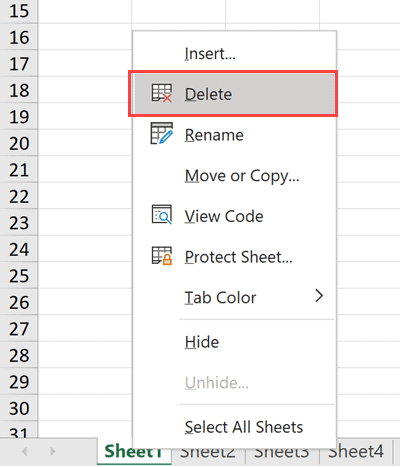How to Quickly Delete an Entire Excel Sheet

Managing Excel spreadsheets can often seem like a daunting task, especially when dealing with extensive workbooks containing multiple sheets. Sometimes, the need to quickly delete an entire sheet arises either to streamline your workbook or to remove outdated or unnecessary data. Whether you are a business analyst, a data scientist, or just an avid Excel user, understanding how to efficiently delete a sheet in Excel can save you time and ensure your work remains well-organized. This guide will walk you through various methods to delete an entire Excel sheet, discussing different scenarios and providing tips for working efficiently with Excel.
Understanding the Basics of Excel Sheets

Before delving into how to delete a sheet, it’s important to understand what sheets are and why they are useful:
- Data Organization: Sheets allow users to segment data into logical units, making it easier to manage complex datasets.
- Work Sharing: Multiple sheets can be shared among team members, enabling collaborative work without the risk of overwriting important data.
- Protection: Excel offers options to protect sheets from accidental modifications or deletions.
Deleting an Excel Sheet: The Basic Methods

Here’s how you can delete a sheet in Excel using the most common methods:
Method 1: Using the Context Menu

- Right-click on the sheet tab you want to delete.
- From the context menu that appears, select Delete.
- Confirm the deletion if prompted with a dialog box.
This method is straightforward and typically used for quick deletions.
Method 2: Using the Ribbon

- Select the sheet tab you wish to delete.
- Go to the Home tab on the Ribbon.
- Click on the Delete dropdown in the Cells group and choose Delete Sheet.
- Confirm the deletion in the dialog box.
Using the Ribbon offers an alternative for users familiar with Excel’s interface who might prefer navigating through menus.
Method 3: Using Shortcut Keys

For those who like efficiency through keyboard shortcuts:
- Click on the sheet tab to select it.
- Press Alt + E, then L, and finally D on your keyboard.
- Confirm the deletion in the dialog box.
This method is handy when you’re working at speed or have the keyboard at hand.
Special Scenarios for Deleting Sheets

Excel sheets can often be more complex, so here are some special cases and considerations:
When Sheets are Protected

- Before deleting a protected sheet, you’ll need to unprotect it. Navigate to the Review tab, click Unprotect Sheet, and enter the password if one was set.
Deleting Multiple Sheets at Once

- To delete multiple sheets, hold down Ctrl while clicking on the sheet tabs you want to delete, then right-click and choose Delete or use the Ribbon method mentioned above.
Using VBA for Deletion

If you’re comfortable with Visual Basic for Applications (VBA):
Sub DeleteSheet()
Dim ws As Worksheet
For Each ws In ThisWorkbook.Worksheets
If ws.Name = “SheetYouWantToDelete” Then
Application.DisplayAlerts = False
ws.Delete
Application.DisplayAlerts = True
Exit Sub
End If
Next ws
End Sub
💡 Note: VBA can automate the deletion process, but use with caution as it can execute actions instantly without warnings.
Precautions Before Deleting Sheets

- Backup Your Data: Always ensure you have a backup of your workbook or at least the sheets you are considering deleting.
- Check for References: Excel might have references to cells in the sheet you want to delete, which can cause errors after deletion. Use the Find & Select tool to locate such references.
- Confirm the Deletion: Deleting a sheet is permanent (unless you’ve saved a backup). Excel will generally prompt for confirmation, but heed the warning.
Advanced Tips for Managing Sheets

Beyond deletion, here are some advanced techniques:
Organizing Sheets

- You can rearrange sheet tabs by dragging them to new positions, or use the View tab’s Custom Views to save and recall specific workbook layouts.
Color Coding Sheets

- Right-click on the sheet tab, choose Tab Color, and select a color to visually distinguish sheets from one another.
Using Group Sheets

- Hold Shift to select multiple contiguous sheets or Ctrl for non-contiguous, to group them for simultaneous editing.
In your daily work with Excel, understanding how to manage sheets effectively is key to productivity. Deleting sheets can clean up your workbook, making it less cluttered and easier to navigate. Remember, while Excel provides various methods for deletion, each comes with its level of caution. Taking the time to ensure you're deleting the right sheets, having backups, and managing references can prevent potential data loss.
Whether you're dealing with a small project or a massive dataset, Excel's flexibility allows you to tailor your approach to sheet management. From basic deletion techniques to advanced VBA scripting, there’s a method for everyone. Implementing these practices will not only help you work smarter but also make you more proficient in handling complex spreadsheets, ensuring that your Excel workflow remains streamlined and error-free.
What happens if I delete a sheet with data used by other sheets?

+
If you delete a sheet that contains cells referenced by formulas in other sheets, those formulas will return errors. Ensure you update or remove such references before deleting the sheet or consider moving the data to another location.
Can I recover a deleted Excel sheet?
+
Excel does not provide an undelete feature for sheets. If you’ve deleted a sheet without a backup, your only chance of recovery is through an auto-recovery feature if enabled, or professional data recovery software, though success isn’t guaranteed.
How can I prevent others from deleting sheets?
+
You can protect your workbook structure by going to File > Info > Protect Workbook and selecting Protect Structure and Windows. This prevents others from adding, deleting, or even rearranging sheets without the password.